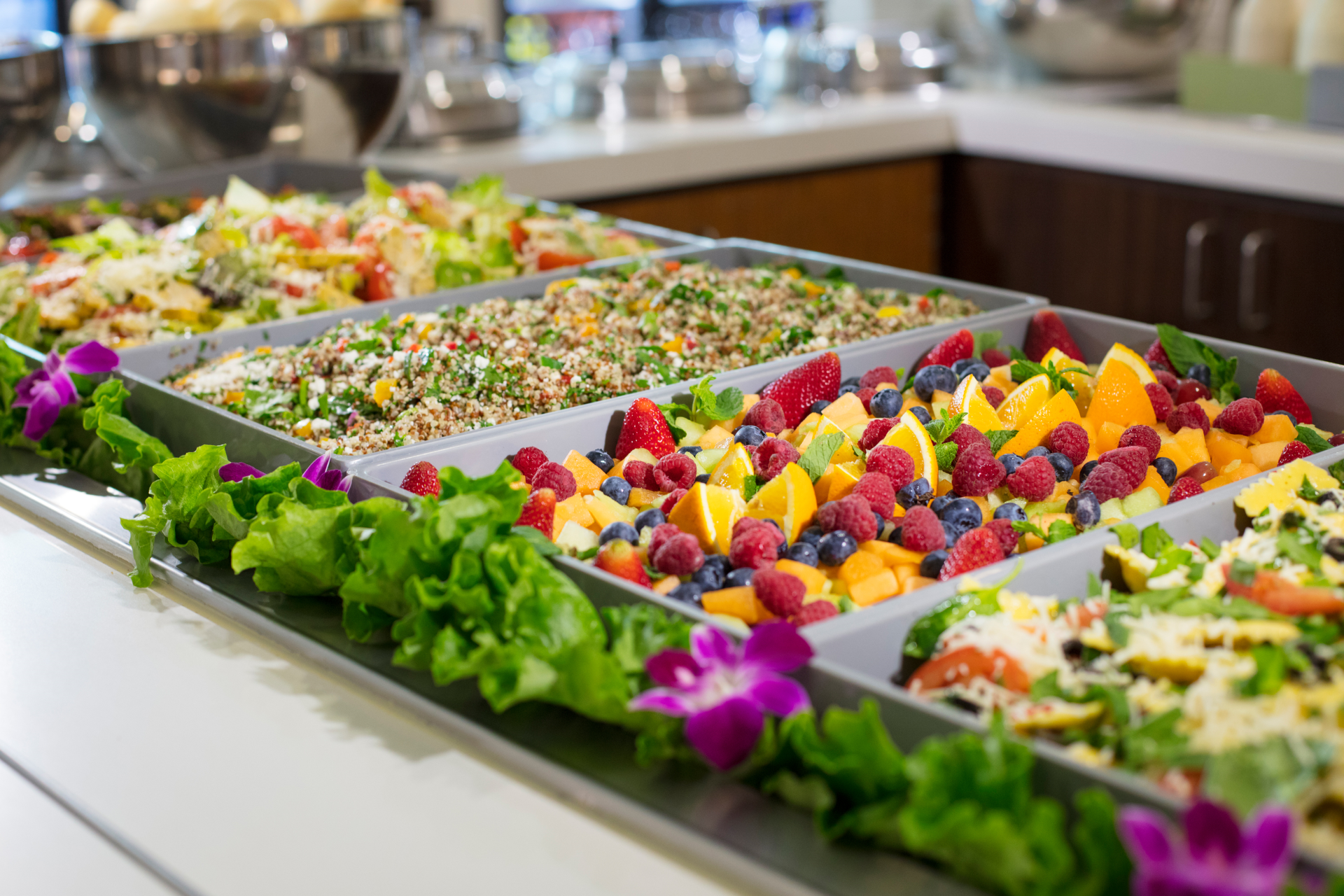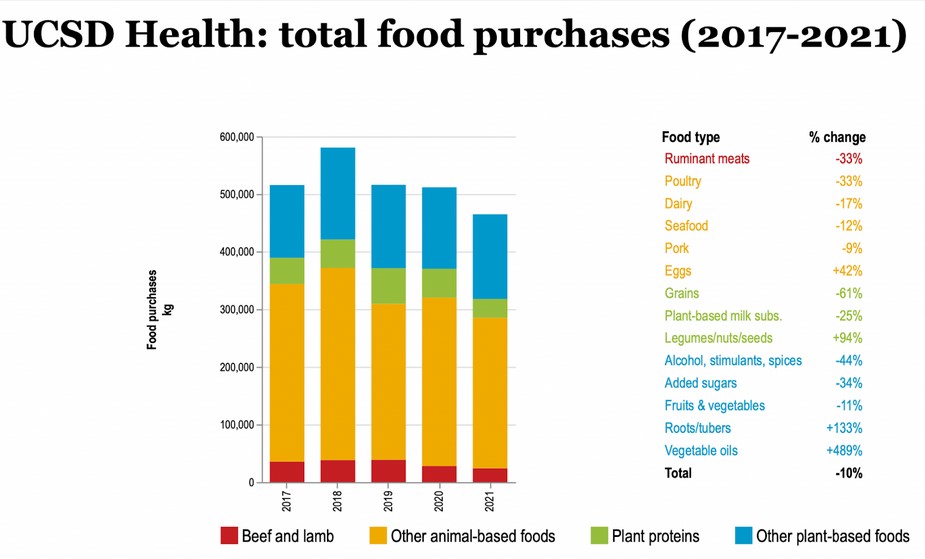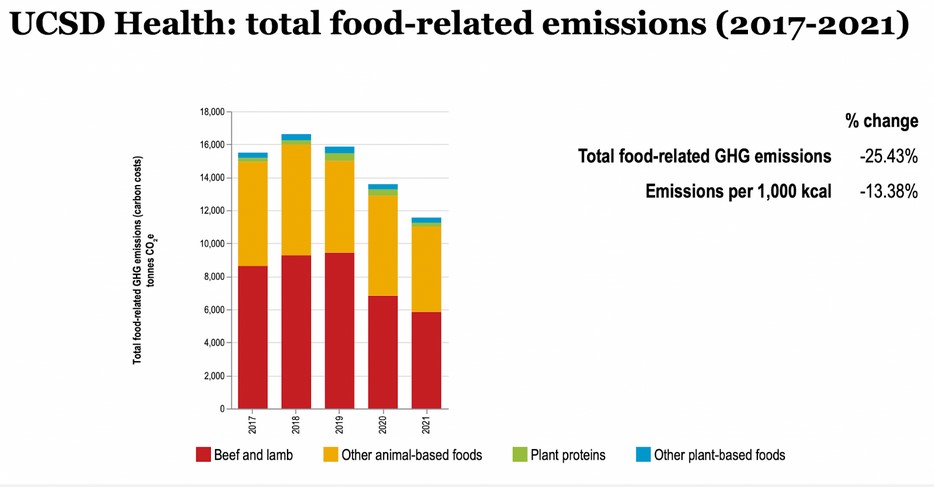A focus on serving better food for our planet and our patients
University of California San Diego Health, United States
Case study summary
UC San Diego’s commitment to the Cool Food Pledge has led the system to develop tools and programs to procure and serve more plant-based meals while increasing the use of local and seasonal offerings. The goal of Cool Food is to reduce GHGs from food purchasing by 25% by 2030.
Demographic information
- City: San Diego
- State/province/region: California
- Country: United States
- Type of institution: Academic medical center
- Number of full-time staff: 8,587
- Number of beds (if applicable): 808
- Patient population served annually
- 241,375 patients served annually (inpatient stays)
- Geographic area served: San Diego County including portions of Imperial and Riverside counties
- Health equity concerns experienced by your population: The San Diego 2022 community health needs assessment identified the top community health needs but did not assess the interconnected nature of the needs. The top needs (access to health care, aging care and support, behavioral health, children and youth well-being, chronic health conditions, community safety, and economic stability) are exacerbated by the foundational challenges of health disparities and workforce shortages. Stigma and trauma act as additional barriers that became more pervasive during the pandemic.

The issue
As UC San Diego learned more about food-related greenhouse gas (GHG) emissions and the effects they have on the environment, patients, and staff, they knew they needed to act. Through Health Care Without Harm and Practice Greenhealth, the system learned that food production contributes to 25% of global GHG emissions, as well as the impacts of animal protein use.
A plant-based diet can lower the risk of certain diseases, improve health and well-being, and reduce the demand for meat. Livestock production is responsible for approximately 14.5% of global GHG emissions and has been linked to the rise of antibiotic-resistant infections from the overuse and misuse of antibiotics in animal agriculture. By promoting sustainable, local purchasing and a plant-forward menu, UC San Diego planned to reduce its GHG emissions and protect patient health.

What contributed to this project's success was that we have a lot of creative control being a self-op organization. We are able to select the products that we want to use and create our own recipes and menus. Innovation is exciting and fun for our team!
Hospital goals
- System wide goal to reduce GHGs of food purchases through globally inspired, culturally acceptable, plant-forward menu design
- Reduce GHG emissions associated with food served by 25% by 2030 via the Cool Food Pledge
- Reduce GHG emissions in support of a system-wide commitment to net zero
- Improve the health of patients and staff
Sustainability strategy implemented
UC San Diego’s strategy to reduce GHG emissions was decreasing the amount of animal protein being used in patient and retail menus and increasing the use of plants and plant proteins. The system aimed to make lasting changes and build on each step. The food and nutrition team started small with the easiest changes that would have the biggest impact. They wanted staff to see their efforts and invest in their work to foster meaning and accountability. Success requires the work of the entire team, so it was clear buy-in from all sides was necessary in order to be successful.

Implementation process
The health system’s work included offering alternative proteins in the café and on patient menus, such as a build-your-own option where plant proteins were offered as the entrée or topping instead of animal protein. Some of the modified items included a Greek wrap with chickpeas in place of chicken and a fiesta bowl with tofu or salmon. UC San Diego also expanded its vegetarian and vegan options to include items like pasta carbonara and a portobello Napa Valley sandwich.
UC San Diego’s executive chef, director, assistant directors, and patient managers first discussed strategy. Once the team crafted a plan, they brought in additional managers and culinary and service staff. They also sought support from clinical staff outside of the food and nutrition department who shared an interest in moving toward a plant-based future.
Throughout the project, the team educated staff about the work and the reasons behind it. They used terminology like “plant-based” or “cool food,” which tend to be more enticing to customers than “vegetarian” or “vegan.”
The team started small with a few recipes and focused on replacing higher GHG-emitting animal proteins like beef. They trained staff on production, made changes in the cafe and for patients, gathered feedback, and then moved on to a few more recipes. The initial process took about a year, but the team has found that gradual progress leads to lasting change. Menus are reviewed quarterly for opportunities to make updates.
Tracking progress
UC San Diego Health was one of the first hospitals to commit to the Cool Food Pledge in 2018. Every year, UC San Diego submits food purchasing data by weight to analyze its GHG impact and measure progress towards the Cool Food goal. Every Cool Food Pledge participant receives a report that identifies the food categories that have the highest GHG impact and that quantifies the results of plant-forward efforts.
Working with HCWH and joining the Cool Food Pledge helped UC San Diego manage its progress and provided tools to support making changes. Another partnership with Key Green Solutions was key in being able to report data efficiently.


Progress achieved
Environmental benefit: Over five years, with a baseline of 2017, UC San Diego has reduced its emissions by 25.43%, which is equivalent to taking 837 vehicles off the road. The system reports being pleased with its progress but still strives to continue their work towards a plant-forward future, knowing that the global food system must continue to reduce its impact beyond the Cool Food goal.
Financial benefit: The original goal was to improve GHG emissions, but there was an additional reward in cost savings achieved from purchasing less meat. UC San Diego was able to improve the quality and type of meat they were still purchasing and saw a reduction in annual meat expenditure by about $60K.
Challenges and lessons learned
The UC San Diego team was surprised by the project’s impact and how quickly they were able to realize their goals. Their main takeaway was “don’t bite off more than you can chew.” In order for change to last, teams must start with the right recipes or menu items that have a high likelihood of being successful and making an impact. The team suggests considering what meats are used a lot that could easily be exchanged. For instance, could a beef stew be served with less beef and more vegetables? Could a frequently served beef chili instead be a bean chili? The team discourages focusing on seldom-ordered menu items or recipes at the beginning of a project. Rather, they suggest finding one item or recipe that has the greatest chance for a large impact.
Next steps
UC San Diego continues to modify its menus to include more plant-based options, and they are incorporating more plant-forward items into their standard menus for both patients and customers in retail settings. Their next steps will involve procurement practices with a focus on purchasing regenerative agriculture to further reduce GHG emissions.